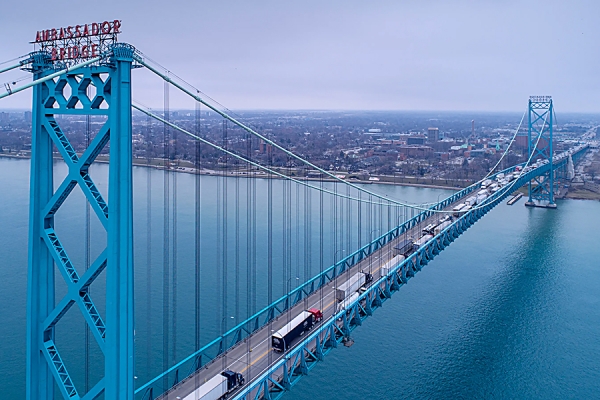 Researchers at UWindsor’s Cross-Border Institute are upgrading cameras and sensors on the Canadian side of the Ambassador Bridge as part of a $206,000 project to better predict border traffic.
Researchers at UWindsor’s Cross-Border Institute are upgrading cameras and sensors on the Canadian side of the Ambassador Bridge as part of a $206,000 project to better predict border traffic.
Researchers at the University of Windsor are upgrading a network of cameras and sensors on the Canadian side of the Ambassador Bridge in a project that aims to better predict border traffic and improve safety.
 Engineering professor Hanna Maoh (pictured at left) and lead researchers at UWindsor’s Cross-Border Institute hope to begin installing the equipment along Huron Church Road this fall. They’ve received $150,000 through the Canadian Foundation for Innovation and the Ontario Research Fund toward the $206,000 project.
Engineering professor Hanna Maoh (pictured at left) and lead researchers at UWindsor’s Cross-Border Institute hope to begin installing the equipment along Huron Church Road this fall. They’ve received $150,000 through the Canadian Foundation for Innovation and the Ontario Research Fund toward the $206,000 project.
“We’re trying to understand how traffic moves through this major node,” said Dr. Maoh. “Collecting data in real time is critical for any meaningful analysis.”
The Cross-Border Institute, founded by political science professor Bill Anderson in 2008, researches ways to better move people, goods, and services across borders. This latest project will use machine learning and artificial intelligence to measure and predict traffic patterns, improving the efficiency of border crossings. Data from cameras and sensors near the bridge will be transferred wirelessly in real time to servers at the institute for analysis by a team of researchers from a variety of disciplines.
Traffic sensors in place right now measure the number and size of vehicles. This project will collect additional data on factors such as lane changes, vehicle speed, and the interaction of large trucks and smaller passenger vehicles.
The information collected will not only assist truckers and local traffic, but could also improve air quality for local residents, improve the supply chain operation between Canada and the United States, and increase the competitiveness of manufacturers and the transportation industry.
Maoh said the ultimate goal is for border traffic predictions to become as commonplace as weather forecasting.
Another objective of the project is to develop a commercial application for the data collected. Trucks could be outfitted with special tablets that display wait times and identify bottlenecks in real time. For example, a trucker leaving a loading dock in Greater Toronto area will know what traffic will look like four hours down the road. That trucker can decide to proceed to the Ambassador Bridge or head toward Sarnia instead as live traffic predictions will be provided continuously.
The data collected can be used in computer simulations of the interaction between cars and trucks. The models could be used to better time stoplights, alter speed limits, and set other public policies related to highways and bridge crossings.
Maoh said the project can be expanded to include simulations for the Gordie Howe International Bridge once it opens.
“This would ultimately improve safety because we know that accidents involving big trucks are more lethal.”
The five-year project offers research and training opportunities for 12 students and post-doctoral fellows. It will also involve partnerships with industry and public agencies.
“Improving the performance of border crossings will enhance the competitiveness of Canadian producers in North American and global markets,” Maoh said. “We want to establish Canada as the world leader in border management practice and technology.”
—Sarah Sacheli
